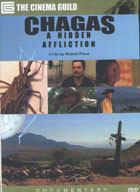
Chagas – a Hidden Affliction 2005
Distributed by Cinema Guild, 115 West 30th Street, Suite 800, New York, NY 10001; 212-685-6242
Produced by n/a
Directed by Ricardo Preve
DVD, color, 85 min.
College - Adult
Health Sciences, Latin American Studies, Sociology
Date Entered: 10/26/2007
Reviewed by Charlotte Diana Moslander, MS, MA, Assistant Director of Library Services, St. Francis College, Brooklyn, NYChagas is a parasitic trypanosome that is transmitted by the feces of a blood-sucking insect called, depending upon the country, vincucha or chinche; by transfused blood products; transplanted tissues and organs; and across the placenta. It is endemic from Mexico south, and it is incurable. The trypanosome invades the entire body, eventually lodging in and destroying the heart. The medication used to control the disease generally is used only in pediatric and acute adult cases and has severe side effects; another medication was withdrawn from the market by the manufacturer (Bayer) because it was unprofitable. In this documentary, Ricardo Preve returns to his childhood home in northwestern Argentina after an absence of more than 20 years and finds that his old friend Osvaldo is ill with chagas. During his journey to find out more about the disease, Preve takes the viewer along on a multi-country, multi-lingual (Portuguese, Spanish, and French with English subtitles, and English) trip through the Argentine public health system, the World Health Organization, a research facility in France, an MD’s office in the United States, and man-in-the-Parisian-street interviews that highlight the fact that most Europeans and Americans north of Mexico never have heard of chagas. This ignorance is especially dangerous because someone who is infected with the trypanosome often is asymptomatic until the acute end stage, so poor, infected people who emigrate to the United States and Canada and sell their blood to make some money can spread the disease to recipients of that blood because the U. S. and Canadian blood supplies are not tested for chagas. The audio and video are excellent, but this documentary suffers from the same gratuitous shots of the outsides of buildings, people walking along the street, and lingering images of children and their mothers that many PBS “specials” have. They extend the running time, but they do nothing to advance the narrative. The conflict between the morbidity statistics reported by the Argentine authorities and the reality experienced by physicians and discovered and publicized by reporters is shown through interviews, without commentary. This same restraint allows the viewer to draw his/her own conclusions about the severity of the impending public health crisis in the U. S. and Canada.
Its length makes this program unsuitable for classroom use, although it could be assigned as supplemental viewing. It might be used as part of a series of general adult programs in an open-to-the-public setting. It is not technical enough and too heavy on human interest to be useful in a public health or parasitology setting. It was assigned a “recommended” rating because of its overall quality, but its usefulness in an academic setting would be very limited.